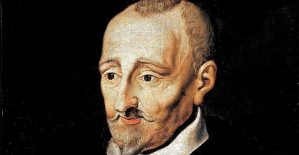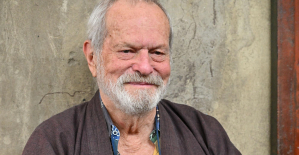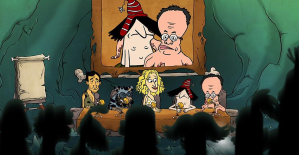There's a surefire way to amaze your counterpart when chatting about holiday destinations: Simply announce that you'll be spending your next holiday in Aargau. So that one voluntarily renounces all the places where Switzerland fulfills its obligation to be spectacularly beautiful, and ignores model cities like Basel, St. Moritz, Zurich or model mountains like Jungfrau, Rigi, Matterhorn.
In fact, many only know Aargau as a backdrop in front of the car window, as a transit, industrial and buffer canton in northern Switzerland. But if you exit the autobahn, you'll be amazed: it's quiet and green here instead of gray and noisy. The historic regions of Aargau - the Fricktal, Baden, Bernese Aargau and Freiamt - are rich in blackbird-fluted meadows, light pine forests, lush pastures and traditional wine-growing villages.
Its greatest natural treasures include the hilly landscape of the Chain and Table Jura in the Aargau Jura Park and Switzerland's "moated castle", a large floodplain area where the rivers Aare, Reuss and Limmat meet. More water flows together here than in the rest of Switzerland, much to the delight of many highland cattle and water buffalo, which are used to care for the meadow landscape and can be observed bathing.
The unmistakable message of Aargau is: There are more beavers, trout, kingfishers and trees here than factories and commercial areas. The fact that the canton also has significantly more monasteries, palaces and castles than nuclear power plants, of which there are three in its area, is because one of the most powerful European noble families once felt very comfortable in this area - the Habsburgs. May the Viennese have the patent on Sisi and the bushy-bearded Emperor Franz Joseph I: the cradle of this ruling dynasty was in Aargau.
Together with parts of Alsace and southern Baden-Württemberg, areas of what is now the Swiss canton of Aargau formed the former Habsburg sovereign territory of Vorderösterreich. Anyone who visits the original scenes of the aristocratic power games really gets to know the Aargau thoroughly, because the legacies of the rulers are numerous there.
The dynasty founded dozens of monasteries and towns such as Baden, Brugg and Bremgarten here, and in many Aargau towns double-headed eagles, Habsburg coats of arms and red-white-red banners still adorn the facades. In the Laufenburg court, Swiss law is still spoken under the portraits of Empress Maria Theresia and her husband Franz I, and every year the city invites you to take a culinary journey through the kitchens of Upper Austria as part of the "Habsburg Weeks in Laufenburg".
The Habsburg Trail, which was inaugurated in 2015 and measures a total of 38 kilometres, is not only an ideal opportunity for fans of the monarchy to discover this former Upper Austria on foot. To the center of power, the eponymous Habsburg, it goes past fields, meadow orchards and vineyards up the Wülpelsberg.
From the upper floor of the castle tower, visitors can practice the view of the lords of the castle and then be served "Habsburger Försterteller", "Rittersalat im Bowl" and wine from the castle's own vines in the castle restaurant.
No matter how stately it is to dine here, in the other rooms of the castle ruins the view of roughly hewn quarry stone walls, high halls and unglazed windows is enough to understand why the noble lords made regular detours from here to Baden to their favorite castle Stein: They were able to warm up quickly in the city's hot springs.
The Romans had already built large thermal baths there, in which the legionnaires from the nearby camp Vindonissa (Windisch) wallowed. They called the place Aquae Helveticae, the "Helvetic waters", which later became so popular with the Habsburg dukes under the name of Baden that they invited Europe's kings, church leaders and polymaths to splash around in the 13th century.
The shimmering in a molehill put Daniel Loosli on the trail of an ancient silver treasure in Aargau. With more than 4000 coins, it is one of the largest hoards in Switzerland.
Source: Canton of Aargau
The city experienced a third heyday as a world health resort of the Belle Époque in the 19th century, when word got around that Baden has the mineral-richest water in Switzerland. The First World War finally put an end to the splendor of the baths, but with a wellness complex designed by star architect Mario Botta, the revival of a thousand-year bath tradition should succeed.
The more than 4000 square meter facility was opened at the end of 2021 and bears the name "Fortyseven", because the water is 47 degrees hot when it springs from the thermal springs. The heated pleasure is supplemented by a large health center with various practices and offers of Chinese medicine.
While some bubble in Botta's bathing paradise, more sporty people move to Bremgarten, also a small Habsburg town surrounded on three sides by the Reuss River. Thanks to Gothic and Baroque buildings decorated with bay windows, Bremgarten is a perfect place for nostalgics, but also a favorite destination for water fans thanks to the "standing waves" that two weirs create.
The wave at the lower Honegger weir is known well beyond the canton's borders as a scene hotspot for surfers, while the wave at the upper weir inspires experienced canoeists. Kayak, canoe and rubber boat paddlers can also start a river trip from the town through one of the largest and most unspoilt natural landscapes of the Swiss Mittelland.
So river surfing on the Reuss – who still wants to go to the sea? As a canton for all seasons, Aargau is not only attractive in summer, because numerous vineyard and cultural trails invite you to go on long hikes in autumn.
Aargau is also an alternative in winter, the sledge slopes, cross-country ski runs and snowshoe routes of the Mittelland are rightly considered real insider tips, which the classic Switzerland travel guides just as little mention as all the other attractions in the canton. However, in view of the comparatively low altitudes - the Geissfluegrat is the highest elevation at 908 meters above sea level - snow is not guaranteed.
If you don't go paddling from Bremgarten, you can head towards the next highlight on the Reuss bank path - Muri Monastery. It is towered over by a snow-white church, from which the wings of the former Benedictine abbey cleverly branch off on both sides, as if the monastery were standing there with its arms spread wide.
Two tall towers soar like double exclamation marks above a mighty roof pyramid, on top of which an angel blowing a trumpet dances. A bad conscience can look so great when it has turned to stone.
More than 1200 years ago, Count Radbot, builder of the Habsburgs on the Wülpelsberg, and his wife Ita were plagued by pangs of conscience because of their sins. To atone for them, they donated the building of the monastery. Both are buried in the nave of the church. However, most visitors are drawn to the former north wing of the cloister to the Loreto Chapel.
Behind the chapel's cheerful blue altar, reminiscent of naïve peasant painting, stands a black marble stele, not visible to the viewer. Inside: the hearts of the last Habsburg imperial couple, Karl I and Zita. Crowned in 1916, in the middle of the First World War, driven into exile in Switzerland two years later and died in exile on Madeira at the age of only 35 – that is the summary of Charles’ reign.
The imperial heart was removed during embalming and is said to have accompanied his wife Zita everywhere for 67 years, all the way to the Swiss retirement home in the Grisons Rhine Valley, where she died in 1989. Her body rests in the Capuchin Crypt in Vienna, her heart in Muri; this was what Austria's last empress and the rest of the Habsburg family wanted and arranged.
Habsburg paths have led out from the front of Austria all over the world. 28 generations after the first Habsburgs, the paths of the dynasty with Karl I and Zita end where it all began: in Aargau.
Getting there: The canton capital of Aarau can be reached by train from Germany at regular intervals via Basel or Zurich (sbb.ch; bahn.de). In Aargau itself, you can easily get around by train or postbus (postauto.ch). If you are traveling by car: there are several bridges over the border river Rhine between Aargau and Baden-Württemberg, including the Rheinfelden motorway crossing.
Accommodation: "Limmathof", until the opening of Mario Botta's thermal bath (fortyseven.ch), the four-star hotel in Baden was the only thermal bath still in operation; Spa suites with whirlpool, sauna and relaxation area can be rented by the hour. Double rooms cost from the equivalent of 230 euros, limmathof.ch. The house in Oberlunkhofen near Kloster Muri has been owned by the Hagenbuch family for around 170 years. "Conditions
Castles and monasteries: Habsburg Castle, the ancestral seat of the Habsburgs on the Wülpelsberg, is open all year round, admission is free, schlosshabsburg.ch.
Lenzburg Castle is one of the most beautiful hilltop castles in the country, dating back to the 11th and 12th centuries. Dating back to the 19th century and enthroned on a hill above the historic old town, admission to the castle and museum costs the equivalent of 14 euros, the complex is closed in winter, schloss-lenzburg.ch.
Kloster Muri, the once influential Benedictine monastery, was founded in 1027 and is one of the most important cultural monuments in Aargau. The adjoining museum tells the story of the almost 1000-year-old complex, open all year round except Mondays and public holidays, entrance fee is 15 euros, murikultur. ch. The monastery church can be explored as part of a guided tour, klosterkirche-muri.ch.
Experience nature: Habsburger Weg: The 38-kilometer-long path consists of three sections that can be hiked independently of each other, it is provided with information boards; Overview maps and further information at habsburgerweg.ch.
Jurapark Aargau: The regional nature park with its vineyards, dry stone walls and standard orchards offers opportunities for exercise, relaxation and discovery at any time of the year, jurapark-aargau.ch.
Switzerland's moated castle: The rivers Aare, Reuss and Limmat meet near Brugg. Comprehensive information about the 170-hectare floodplain landscape, guided tours, cycle paths and hiking trails can be found at bruggregio.ch; canoe and boat tours can also be undertaken.
Further information: aargautourismus.ch; myswitzerland.com
A third of all glaciers are in danger of disappearing. "It also affects the Aletsch Glacier in the Swiss Alps," says Dr. Alexander Hildebrand. The meteorologist uses photo comparisons to show how the glacier melt is progressing - and what effects this is having on the Rhine.
Source: WORLD / Alexander Hildebrand

 United States: divided on the question of presidential immunity, the Supreme Court offers respite to Trump
United States: divided on the question of presidential immunity, the Supreme Court offers respite to Trump Maurizio Molinari: “the Scurati affair, a European injury”
Maurizio Molinari: “the Scurati affair, a European injury” Hamas-Israel war: US begins construction of pier in Gaza
Hamas-Israel war: US begins construction of pier in Gaza Israel prepares to attack Rafah
Israel prepares to attack Rafah First three cases of “native” cholera confirmed in Mayotte
First three cases of “native” cholera confirmed in Mayotte Meningitis: compulsory vaccination for babies will be extended in 2025
Meningitis: compulsory vaccination for babies will be extended in 2025 Spain is the country in the European Union with the most overqualified workers for their jobs
Spain is the country in the European Union with the most overqualified workers for their jobs Parvovirus alert, the “fifth disease” of children which has already caused the death of five babies in 2024
Parvovirus alert, the “fifth disease” of children which has already caused the death of five babies in 2024 Falling wings of the Moulin Rouge: who will pay for the repairs?
Falling wings of the Moulin Rouge: who will pay for the repairs? “You don’t sell a company like that”: Roland Lescure “annoyed” by the prospect of a sale of Biogaran
“You don’t sell a company like that”: Roland Lescure “annoyed” by the prospect of a sale of Biogaran Insults, threats of suicide, violence... Attacks by France Travail agents will continue to soar in 2023
Insults, threats of suicide, violence... Attacks by France Travail agents will continue to soar in 2023 TotalEnergies boss plans primary listing in New York
TotalEnergies boss plans primary listing in New York La Pléiade arrives... in Pléiade
La Pléiade arrives... in Pléiade In Japan, an animation studio bets on its creators suffering from autism spectrum disorders
In Japan, an animation studio bets on its creators suffering from autism spectrum disorders Terry Gilliam, hero of the Annecy Festival, with Vice-Versa 2 and Garfield
Terry Gilliam, hero of the Annecy Festival, with Vice-Versa 2 and Garfield François Hollande, Stéphane Bern and Amélie Nothomb, heroes of one evening on the beach of the Cannes Film Festival
François Hollande, Stéphane Bern and Amélie Nothomb, heroes of one evening on the beach of the Cannes Film Festival Skoda Kodiaq 2024: a 'beast' plug-in hybrid SUV
Skoda Kodiaq 2024: a 'beast' plug-in hybrid SUV Tesla launches a new Model Y with 600 km of autonomy at a "more accessible price"
Tesla launches a new Model Y with 600 km of autonomy at a "more accessible price" The 10 best-selling cars in March 2024 in Spain: sales fall due to Easter
The 10 best-selling cars in March 2024 in Spain: sales fall due to Easter A private jet company buys more than 100 flying cars
A private jet company buys more than 100 flying cars This is how housing prices have changed in Spain in the last decade
This is how housing prices have changed in Spain in the last decade The home mortgage firm drops 10% in January and interest soars to 3.46%
The home mortgage firm drops 10% in January and interest soars to 3.46% The jewel of the Rocío de Nagüeles urbanization: a dream villa in Marbella
The jewel of the Rocío de Nagüeles urbanization: a dream villa in Marbella Rental prices grow by 7.3% in February: where does it go up and where does it go down?
Rental prices grow by 7.3% in February: where does it go up and where does it go down? Even on a mission for NATO, the Charles-de-Gaulle remains under French control, Lecornu responds to Mélenchon
Even on a mission for NATO, the Charles-de-Gaulle remains under French control, Lecornu responds to Mélenchon “Deadly Europe”, “economic decline”, immigration… What to remember from Emmanuel Macron’s speech at the Sorbonne
“Deadly Europe”, “economic decline”, immigration… What to remember from Emmanuel Macron’s speech at the Sorbonne Sale of Biogaran: The Republicans write to Emmanuel Macron
Sale of Biogaran: The Republicans write to Emmanuel Macron Europeans: “All those who claim that we don’t need Europe are liars”, criticizes Bayrou
Europeans: “All those who claim that we don’t need Europe are liars”, criticizes Bayrou These French cities that will boycott the World Cup in Qatar
These French cities that will boycott the World Cup in Qatar Medicine, family of athletes, New Zealand…, discovering Manae Feleu, the captain of the Bleues
Medicine, family of athletes, New Zealand…, discovering Manae Feleu, the captain of the Bleues Football: OM wants to extend Leonardo Balerdi
Football: OM wants to extend Leonardo Balerdi Six Nations F: France-England shatters the attendance record for women’s rugby in France
Six Nations F: France-England shatters the attendance record for women’s rugby in France Judo: eliminated in the 2nd round of the European Championships, Alpha Djalo in full doubt
Judo: eliminated in the 2nd round of the European Championships, Alpha Djalo in full doubt


















